Final Research Proposal: Dividend Policy & Firm Performance in Nepal
VerifiedAdded on 2021/01/15
|16
|4100
|350
Project
AI Summary
This research proposal investigates the impact of dividend policy on the financial performance of Nepalese commercial banks listed on the Nepal Stock Exchange (NEPSE). The study aims to analyze the relationship between dividend policies and firm performance, focusing on Return on Assets (ROA), Earnings Per Share (EPS), and Return on Capital Employed. The proposal includes a comprehensive literature review covering agency theory, signaling theory, the bird-in-the-hand theory, residual theory, and empirical studies. It outlines the research questions, methodology involving quantitative techniques, and potential limitations. The research seeks to determine the factors affecting firm performance and their implications, contributing to a better understanding of how dividend decisions influence the financial success of commercial banks in Nepal. The proposal also includes a conceptual framework and a time schedule for the research.
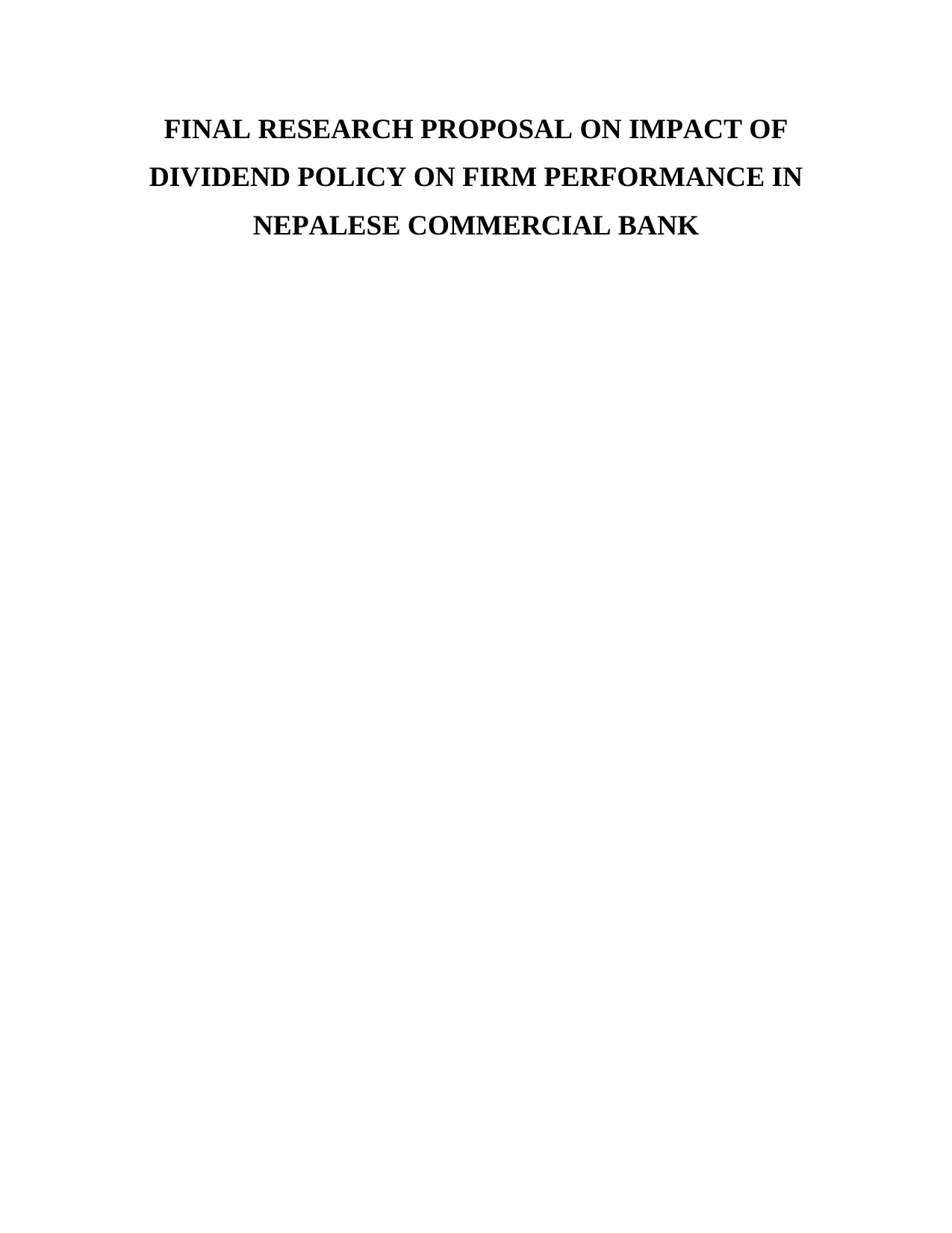
FINAL RESEARCH PROPOSAL ON IMPACT OF
DIVIDEND POLICY ON FIRM PERFORMANCE IN
NEPALESE COMMERCIAL BANK
DIVIDEND POLICY ON FIRM PERFORMANCE IN
NEPALESE COMMERCIAL BANK
Paraphrase This Document
Need a fresh take? Get an instant paraphrase of this document with our AI Paraphraser
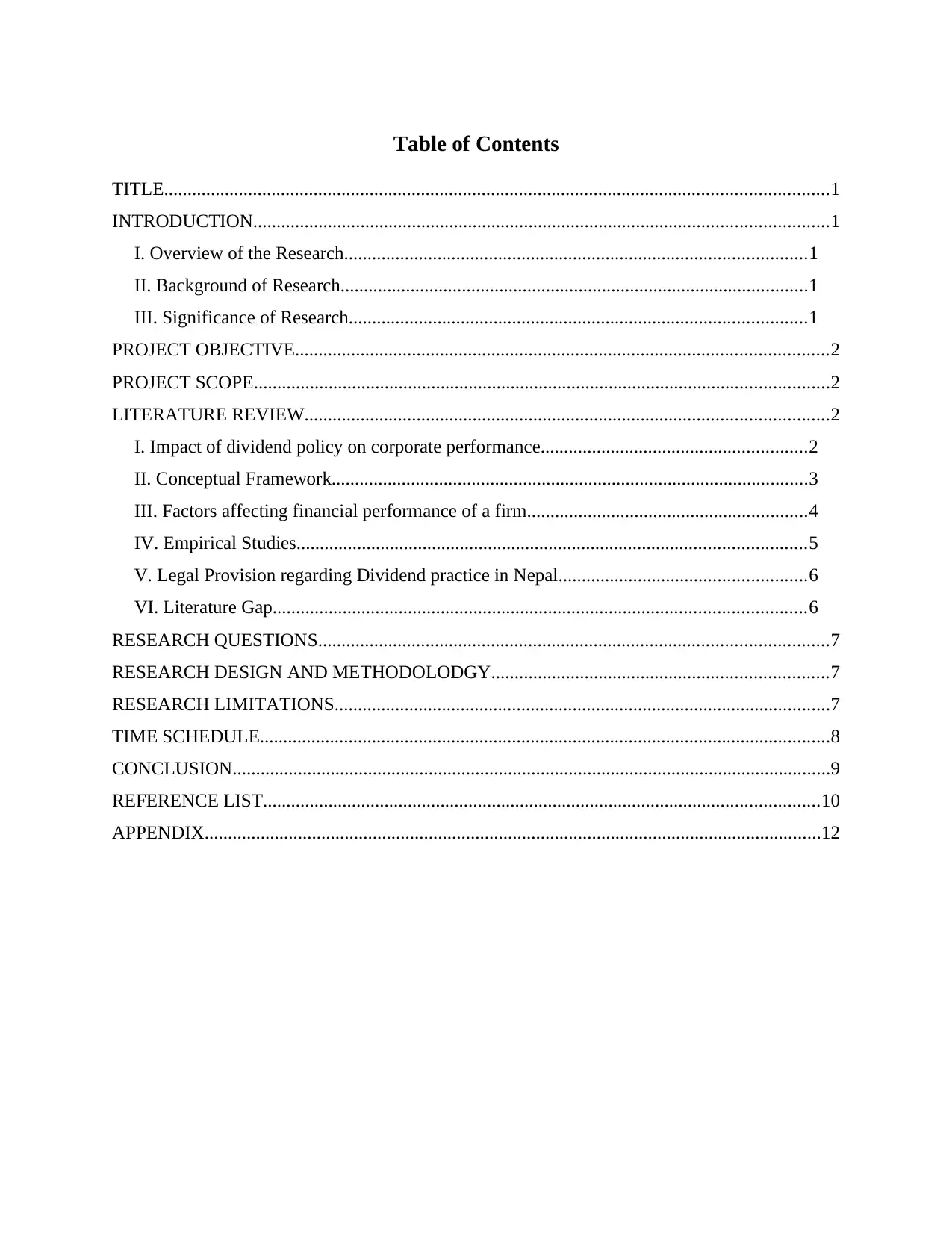
Table of Contents
TITLE..............................................................................................................................................1
INTRODUCTION...........................................................................................................................1
I. Overview of the Research...................................................................................................1
II. Background of Research....................................................................................................1
III. Significance of Research..................................................................................................1
PROJECT OBJECTIVE..................................................................................................................2
PROJECT SCOPE...........................................................................................................................2
LITERATURE REVIEW................................................................................................................2
I. Impact of dividend policy on corporate performance.........................................................2
II. Conceptual Framework......................................................................................................3
III. Factors affecting financial performance of a firm............................................................4
IV. Empirical Studies.............................................................................................................5
V. Legal Provision regarding Dividend practice in Nepal.....................................................6
VI. Literature Gap..................................................................................................................6
RESEARCH QUESTIONS.............................................................................................................7
RESEARCH DESIGN AND METHODOLODGY........................................................................7
RESEARCH LIMITATIONS..........................................................................................................7
TIME SCHEDULE..........................................................................................................................8
CONCLUSION................................................................................................................................9
REFERENCE LIST.......................................................................................................................10
APPENDIX....................................................................................................................................12
TITLE..............................................................................................................................................1
INTRODUCTION...........................................................................................................................1
I. Overview of the Research...................................................................................................1
II. Background of Research....................................................................................................1
III. Significance of Research..................................................................................................1
PROJECT OBJECTIVE..................................................................................................................2
PROJECT SCOPE...........................................................................................................................2
LITERATURE REVIEW................................................................................................................2
I. Impact of dividend policy on corporate performance.........................................................2
II. Conceptual Framework......................................................................................................3
III. Factors affecting financial performance of a firm............................................................4
IV. Empirical Studies.............................................................................................................5
V. Legal Provision regarding Dividend practice in Nepal.....................................................6
VI. Literature Gap..................................................................................................................6
RESEARCH QUESTIONS.............................................................................................................7
RESEARCH DESIGN AND METHODOLODGY........................................................................7
RESEARCH LIMITATIONS..........................................................................................................7
TIME SCHEDULE..........................................................................................................................8
CONCLUSION................................................................................................................................9
REFERENCE LIST.......................................................................................................................10
APPENDIX....................................................................................................................................12
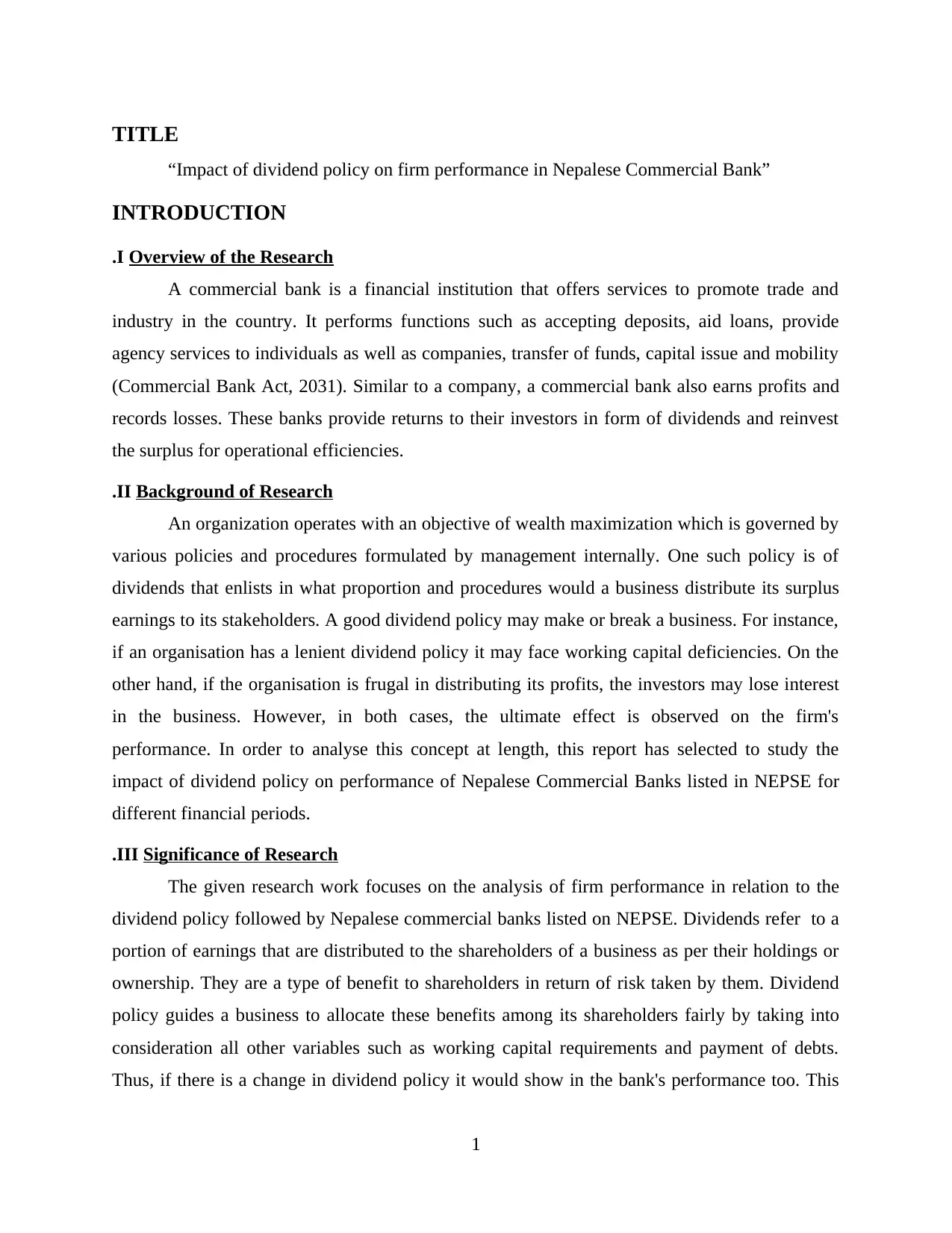
TITLE
“Impact of dividend policy on firm performance in Nepalese Commercial Bank”
INTRODUCTION
.I Overview of the Research
A commercial bank is a financial institution that offers services to promote trade and
industry in the country. It performs functions such as accepting deposits, aid loans, provide
agency services to individuals as well as companies, transfer of funds, capital issue and mobility
(Commercial Bank Act, 2031). Similar to a company, a commercial bank also earns profits and
records losses. These banks provide returns to their investors in form of dividends and reinvest
the surplus for operational efficiencies.
.II Background of Research
An organization operates with an objective of wealth maximization which is governed by
various policies and procedures formulated by management internally. One such policy is of
dividends that enlists in what proportion and procedures would a business distribute its surplus
earnings to its stakeholders. A good dividend policy may make or break a business. For instance,
if an organisation has a lenient dividend policy it may face working capital deficiencies. On the
other hand, if the organisation is frugal in distributing its profits, the investors may lose interest
in the business. However, in both cases, the ultimate effect is observed on the firm's
performance. In order to analyse this concept at length, this report has selected to study the
impact of dividend policy on performance of Nepalese Commercial Banks listed in NEPSE for
different financial periods.
.III Significance of Research
The given research work focuses on the analysis of firm performance in relation to the
dividend policy followed by Nepalese commercial banks listed on NEPSE. Dividends refer to a
portion of earnings that are distributed to the shareholders of a business as per their holdings or
ownership. They are a type of benefit to shareholders in return of risk taken by them. Dividend
policy guides a business to allocate these benefits among its shareholders fairly by taking into
consideration all other variables such as working capital requirements and payment of debts.
Thus, if there is a change in dividend policy it would show in the bank's performance too. This
1
“Impact of dividend policy on firm performance in Nepalese Commercial Bank”
INTRODUCTION
.I Overview of the Research
A commercial bank is a financial institution that offers services to promote trade and
industry in the country. It performs functions such as accepting deposits, aid loans, provide
agency services to individuals as well as companies, transfer of funds, capital issue and mobility
(Commercial Bank Act, 2031). Similar to a company, a commercial bank also earns profits and
records losses. These banks provide returns to their investors in form of dividends and reinvest
the surplus for operational efficiencies.
.II Background of Research
An organization operates with an objective of wealth maximization which is governed by
various policies and procedures formulated by management internally. One such policy is of
dividends that enlists in what proportion and procedures would a business distribute its surplus
earnings to its stakeholders. A good dividend policy may make or break a business. For instance,
if an organisation has a lenient dividend policy it may face working capital deficiencies. On the
other hand, if the organisation is frugal in distributing its profits, the investors may lose interest
in the business. However, in both cases, the ultimate effect is observed on the firm's
performance. In order to analyse this concept at length, this report has selected to study the
impact of dividend policy on performance of Nepalese Commercial Banks listed in NEPSE for
different financial periods.
.III Significance of Research
The given research work focuses on the analysis of firm performance in relation to the
dividend policy followed by Nepalese commercial banks listed on NEPSE. Dividends refer to a
portion of earnings that are distributed to the shareholders of a business as per their holdings or
ownership. They are a type of benefit to shareholders in return of risk taken by them. Dividend
policy guides a business to allocate these benefits among its shareholders fairly by taking into
consideration all other variables such as working capital requirements and payment of debts.
Thus, if there is a change in dividend policy it would show in the bank's performance too. This
1
⊘ This is a preview!⊘
Do you want full access?
Subscribe today to unlock all pages.

Trusted by 1+ million students worldwide
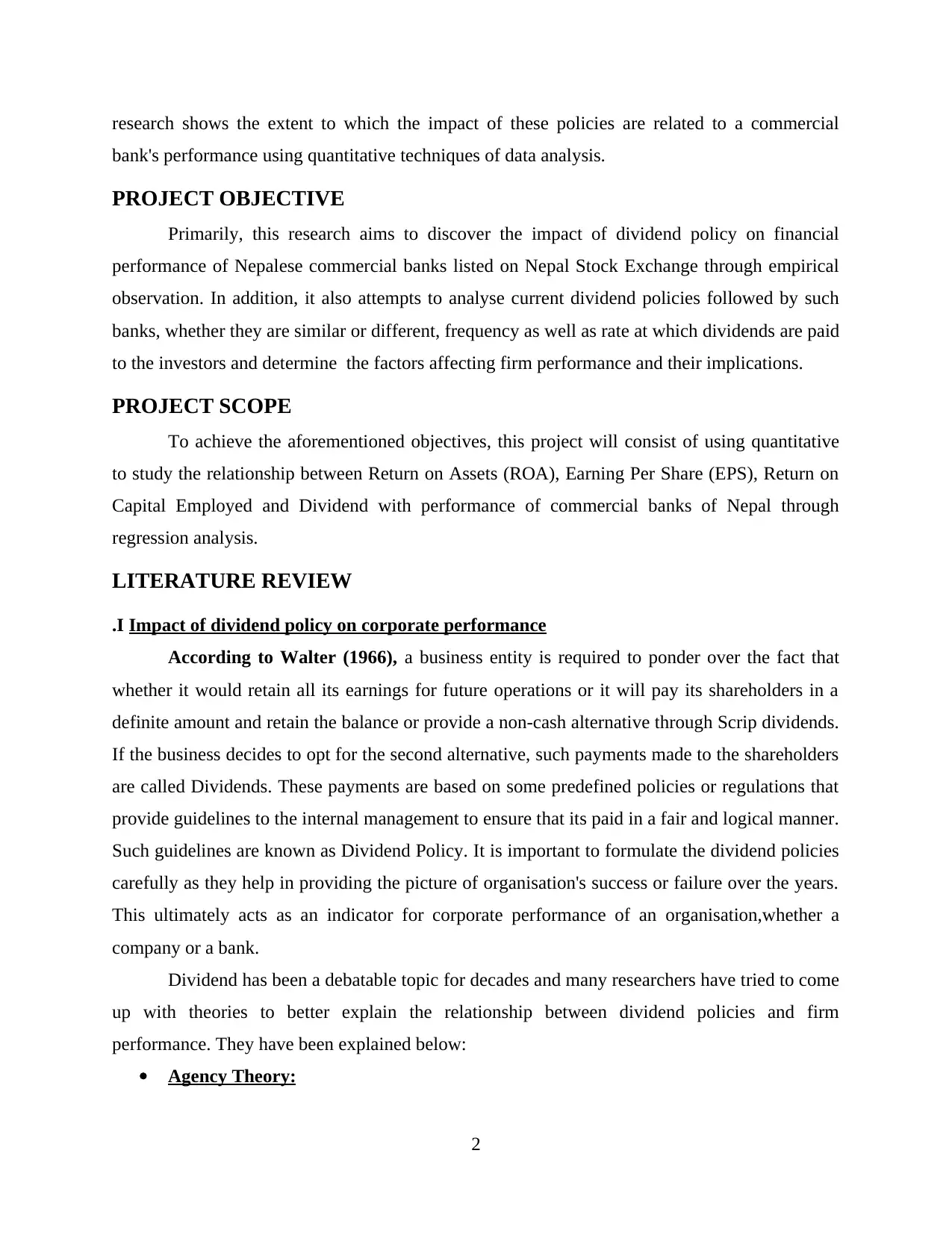
research shows the extent to which the impact of these policies are related to a commercial
bank's performance using quantitative techniques of data analysis.
PROJECT OBJECTIVE
Primarily, this research aims to discover the impact of dividend policy on financial
performance of Nepalese commercial banks listed on Nepal Stock Exchange through empirical
observation. In addition, it also attempts to analyse current dividend policies followed by such
banks, whether they are similar or different, frequency as well as rate at which dividends are paid
to the investors and determine the factors affecting firm performance and their implications.
PROJECT SCOPE
To achieve the aforementioned objectives, this project will consist of using quantitative
to study the relationship between Return on Assets (ROA), Earning Per Share (EPS), Return on
Capital Employed and Dividend with performance of commercial banks of Nepal through
regression analysis.
LITERATURE REVIEW
.I Impact of dividend policy on corporate performance
According to Walter (1966), a business entity is required to ponder over the fact that
whether it would retain all its earnings for future operations or it will pay its shareholders in a
definite amount and retain the balance or provide a non-cash alternative through Scrip dividends.
If the business decides to opt for the second alternative, such payments made to the shareholders
are called Dividends. These payments are based on some predefined policies or regulations that
provide guidelines to the internal management to ensure that its paid in a fair and logical manner.
Such guidelines are known as Dividend Policy. It is important to formulate the dividend policies
carefully as they help in providing the picture of organisation's success or failure over the years.
This ultimately acts as an indicator for corporate performance of an organisation,whether a
company or a bank.
Dividend has been a debatable topic for decades and many researchers have tried to come
up with theories to better explain the relationship between dividend policies and firm
performance. They have been explained below:
Agency Theory:
2
bank's performance using quantitative techniques of data analysis.
PROJECT OBJECTIVE
Primarily, this research aims to discover the impact of dividend policy on financial
performance of Nepalese commercial banks listed on Nepal Stock Exchange through empirical
observation. In addition, it also attempts to analyse current dividend policies followed by such
banks, whether they are similar or different, frequency as well as rate at which dividends are paid
to the investors and determine the factors affecting firm performance and their implications.
PROJECT SCOPE
To achieve the aforementioned objectives, this project will consist of using quantitative
to study the relationship between Return on Assets (ROA), Earning Per Share (EPS), Return on
Capital Employed and Dividend with performance of commercial banks of Nepal through
regression analysis.
LITERATURE REVIEW
.I Impact of dividend policy on corporate performance
According to Walter (1966), a business entity is required to ponder over the fact that
whether it would retain all its earnings for future operations or it will pay its shareholders in a
definite amount and retain the balance or provide a non-cash alternative through Scrip dividends.
If the business decides to opt for the second alternative, such payments made to the shareholders
are called Dividends. These payments are based on some predefined policies or regulations that
provide guidelines to the internal management to ensure that its paid in a fair and logical manner.
Such guidelines are known as Dividend Policy. It is important to formulate the dividend policies
carefully as they help in providing the picture of organisation's success or failure over the years.
This ultimately acts as an indicator for corporate performance of an organisation,whether a
company or a bank.
Dividend has been a debatable topic for decades and many researchers have tried to come
up with theories to better explain the relationship between dividend policies and firm
performance. They have been explained below:
Agency Theory:
2
Paraphrase This Document
Need a fresh take? Get an instant paraphrase of this document with our AI Paraphraser

Jensen and Mackling (1986) explain agency relationship as an agreement between
principal and and agent where principal can be one or more person and an agent is obliged to
perform services on behalf of the former, including decision making. Agency theory states that
dividend payments can prove to be beneficial for the shareholders to control over-investment
problem even if the firm does not have free cash flows. According to Ho (2003), agency
relationships tend to face many conflicts and can increase agency costs. This can result in
management taking actions that are not entirely in the best interest of their investors.
Signalling Theory:
According to Miller and Rock (1985), signalling theory explains that a declaration of
increase in dividend payout ratio of a firm acts as an indicator of future growth for a company.
Thus, if there is an increase in dividend profit or payments, a positive reaction is observed among
the investors for such news and vice versa. This theory essentially works on the information
asymmetry present in the market among the investors and managers.
On the other hand, Miller and Modigliani (1961) state that investors consider dividend
history of a firm irrelevant as the dividend payments are based on the ongoing investment policy
that is followed by the Bank. This results in dividend policy having no effect on price of shares
of firm in a world with no tax levy.
Bird-in-the-hand Theory:
According to Gordon (1962) the bird in the hand theory explains that dividend is a
relevant factor to determine the firm’s value, that is to say, the external users prefer higher
dividend policy over uncertain capital gains in order to earn higher returns on their investments
and vice-versa. Here, the term “a bird-in-the-hand” refers to cash dividends. However, this
theory proves to be unsuccessful where there is no uncertainty and perfect market exists as this
would amount to complete information available in regards to a bank with both investors and
management.
Black, Fisher and Scholes, Myron (1974) observes that dividend policies have been
essentially developed to protect and prioritize shareholder's interest to receive annual returns on
their stock-holdings rather than capital gains. Thus, an investor tends to opt for a high-priced
share yielding current dividends in the market. Amidu (2006) agrees that current dividends or
bird in hand help in minimizing uncertainty of an investor and increasing valuation of an
organisation such as banks.
3
principal and and agent where principal can be one or more person and an agent is obliged to
perform services on behalf of the former, including decision making. Agency theory states that
dividend payments can prove to be beneficial for the shareholders to control over-investment
problem even if the firm does not have free cash flows. According to Ho (2003), agency
relationships tend to face many conflicts and can increase agency costs. This can result in
management taking actions that are not entirely in the best interest of their investors.
Signalling Theory:
According to Miller and Rock (1985), signalling theory explains that a declaration of
increase in dividend payout ratio of a firm acts as an indicator of future growth for a company.
Thus, if there is an increase in dividend profit or payments, a positive reaction is observed among
the investors for such news and vice versa. This theory essentially works on the information
asymmetry present in the market among the investors and managers.
On the other hand, Miller and Modigliani (1961) state that investors consider dividend
history of a firm irrelevant as the dividend payments are based on the ongoing investment policy
that is followed by the Bank. This results in dividend policy having no effect on price of shares
of firm in a world with no tax levy.
Bird-in-the-hand Theory:
According to Gordon (1962) the bird in the hand theory explains that dividend is a
relevant factor to determine the firm’s value, that is to say, the external users prefer higher
dividend policy over uncertain capital gains in order to earn higher returns on their investments
and vice-versa. Here, the term “a bird-in-the-hand” refers to cash dividends. However, this
theory proves to be unsuccessful where there is no uncertainty and perfect market exists as this
would amount to complete information available in regards to a bank with both investors and
management.
Black, Fisher and Scholes, Myron (1974) observes that dividend policies have been
essentially developed to protect and prioritize shareholder's interest to receive annual returns on
their stock-holdings rather than capital gains. Thus, an investor tends to opt for a high-priced
share yielding current dividends in the market. Amidu (2006) agrees that current dividends or
bird in hand help in minimizing uncertainty of an investor and increasing valuation of an
organisation such as banks.
3
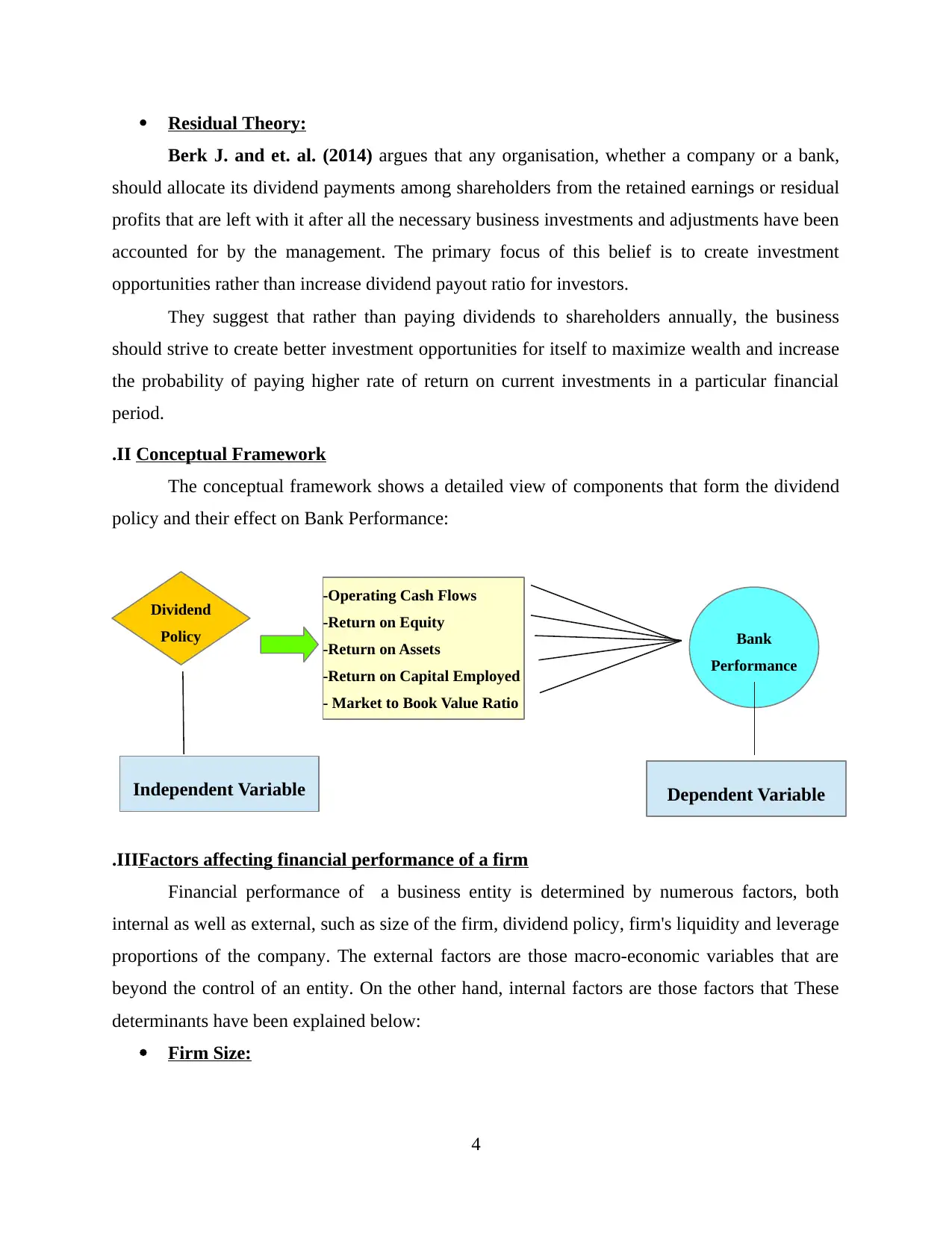
-Operating Cash Flows
-Return on Equity
-Return on Assets
-Return on Capital Employed
- Market to Book Value Ratio
Residual Theory:
Berk J. and et. al. (2014) argues that any organisation, whether a company or a bank,
should allocate its dividend payments among shareholders from the retained earnings or residual
profits that are left with it after all the necessary business investments and adjustments have been
accounted for by the management. The primary focus of this belief is to create investment
opportunities rather than increase dividend payout ratio for investors.
They suggest that rather than paying dividends to shareholders annually, the business
should strive to create better investment opportunities for itself to maximize wealth and increase
the probability of paying higher rate of return on current investments in a particular financial
period.
.II Conceptual Framework
The conceptual framework shows a detailed view of components that form the dividend
policy and their effect on Bank Performance:
.IIIFactors affecting financial performance of a firm
Financial performance of a business entity is determined by numerous factors, both
internal as well as external, such as size of the firm, dividend policy, firm's liquidity and leverage
proportions of the company. The external factors are those macro-economic variables that are
beyond the control of an entity. On the other hand, internal factors are those factors that These
determinants have been explained below:
Firm Size:
4
Dividend
Policy Bank
Performance
Independent Variable Dependent Variable
-Return on Equity
-Return on Assets
-Return on Capital Employed
- Market to Book Value Ratio
Residual Theory:
Berk J. and et. al. (2014) argues that any organisation, whether a company or a bank,
should allocate its dividend payments among shareholders from the retained earnings or residual
profits that are left with it after all the necessary business investments and adjustments have been
accounted for by the management. The primary focus of this belief is to create investment
opportunities rather than increase dividend payout ratio for investors.
They suggest that rather than paying dividends to shareholders annually, the business
should strive to create better investment opportunities for itself to maximize wealth and increase
the probability of paying higher rate of return on current investments in a particular financial
period.
.II Conceptual Framework
The conceptual framework shows a detailed view of components that form the dividend
policy and their effect on Bank Performance:
.IIIFactors affecting financial performance of a firm
Financial performance of a business entity is determined by numerous factors, both
internal as well as external, such as size of the firm, dividend policy, firm's liquidity and leverage
proportions of the company. The external factors are those macro-economic variables that are
beyond the control of an entity. On the other hand, internal factors are those factors that These
determinants have been explained below:
Firm Size:
4
Dividend
Policy Bank
Performance
Independent Variable Dependent Variable
⊘ This is a preview!⊘
Do you want full access?
Subscribe today to unlock all pages.

Trusted by 1+ million students worldwide
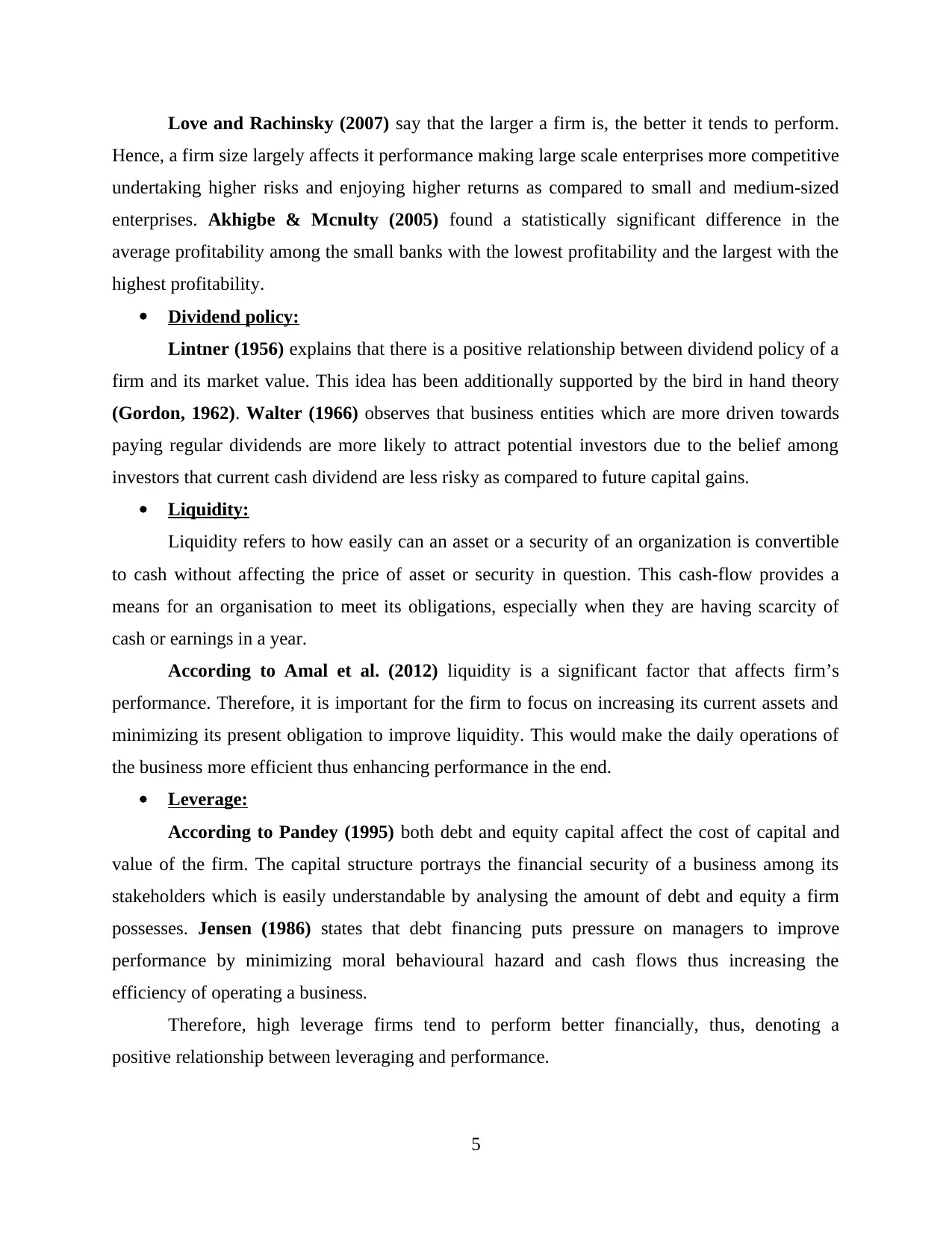
Love and Rachinsky (2007) say that the larger a firm is, the better it tends to perform.
Hence, a firm size largely affects it performance making large scale enterprises more competitive
undertaking higher risks and enjoying higher returns as compared to small and medium-sized
enterprises. Akhigbe & Mcnulty (2005) found a statistically significant difference in the
average profitability among the small banks with the lowest profitability and the largest with the
highest profitability.
Dividend policy:
Lintner (1956) explains that there is a positive relationship between dividend policy of a
firm and its market value. This idea has been additionally supported by the bird in hand theory
(Gordon, 1962). Walter (1966) observes that business entities which are more driven towards
paying regular dividends are more likely to attract potential investors due to the belief among
investors that current cash dividend are less risky as compared to future capital gains.
Liquidity:
Liquidity refers to how easily can an asset or a security of an organization is convertible
to cash without affecting the price of asset or security in question. This cash-flow provides a
means for an organisation to meet its obligations, especially when they are having scarcity of
cash or earnings in a year.
According to Amal et al. (2012) liquidity is a significant factor that affects firm’s
performance. Therefore, it is important for the firm to focus on increasing its current assets and
minimizing its present obligation to improve liquidity. This would make the daily operations of
the business more efficient thus enhancing performance in the end.
Leverage:
According to Pandey (1995) both debt and equity capital affect the cost of capital and
value of the firm. The capital structure portrays the financial security of a business among its
stakeholders which is easily understandable by analysing the amount of debt and equity a firm
possesses. Jensen (1986) states that debt financing puts pressure on managers to improve
performance by minimizing moral behavioural hazard and cash flows thus increasing the
efficiency of operating a business.
Therefore, high leverage firms tend to perform better financially, thus, denoting a
positive relationship between leveraging and performance.
5
Hence, a firm size largely affects it performance making large scale enterprises more competitive
undertaking higher risks and enjoying higher returns as compared to small and medium-sized
enterprises. Akhigbe & Mcnulty (2005) found a statistically significant difference in the
average profitability among the small banks with the lowest profitability and the largest with the
highest profitability.
Dividend policy:
Lintner (1956) explains that there is a positive relationship between dividend policy of a
firm and its market value. This idea has been additionally supported by the bird in hand theory
(Gordon, 1962). Walter (1966) observes that business entities which are more driven towards
paying regular dividends are more likely to attract potential investors due to the belief among
investors that current cash dividend are less risky as compared to future capital gains.
Liquidity:
Liquidity refers to how easily can an asset or a security of an organization is convertible
to cash without affecting the price of asset or security in question. This cash-flow provides a
means for an organisation to meet its obligations, especially when they are having scarcity of
cash or earnings in a year.
According to Amal et al. (2012) liquidity is a significant factor that affects firm’s
performance. Therefore, it is important for the firm to focus on increasing its current assets and
minimizing its present obligation to improve liquidity. This would make the daily operations of
the business more efficient thus enhancing performance in the end.
Leverage:
According to Pandey (1995) both debt and equity capital affect the cost of capital and
value of the firm. The capital structure portrays the financial security of a business among its
stakeholders which is easily understandable by analysing the amount of debt and equity a firm
possesses. Jensen (1986) states that debt financing puts pressure on managers to improve
performance by minimizing moral behavioural hazard and cash flows thus increasing the
efficiency of operating a business.
Therefore, high leverage firms tend to perform better financially, thus, denoting a
positive relationship between leveraging and performance.
5
Paraphrase This Document
Need a fresh take? Get an instant paraphrase of this document with our AI Paraphraser

.IV Empirical Studies
La Porta, R. et al. (2000) conducted a survey to test agency cost hypotheses by taking a
sample size of 4000 companies from 33 countries that were broadly classified into two groups-
countries providing proper legal protection to shareholders and countries providing poor legal
security. This approach adopted two models- an outcome model and substitute model. The
outcome model derived that dividend is a direct product of proper provisioning of legal
protection to a firm's investors which enabled firms to have a high dividend payout ratio
incorporated in their dividend policies. On the other hand, the substitute model derived that
dividends are used to gain good reputation among shareholders present in an environment where
poor legal protection framework is observed. Thus, La Porta, R. et al. (2000) concluded that
agency approach is highly relevant to understand corporate dividend policy across the world.
Nissim and Ziv (2001) carried out a study to gauge relational aspect between change in
dividend and firm's profitability conditions between 1963 and 1968 with the help of regression
analysis where earnings and dividend were considered as dependent and independent variables
respectively. The duo concluded that any change in dividend signalled at a firm's future
profitability level at a given point of time.
Parsian, Koloukhi and Abdolnejad (2013) attempted to ascertain relation between
dividend payout ratio and future earnings by analysing 102 companies and financial institutions
between 2004 and 2010 taking growth as dependent variable and leverage, dividend payout ratio,
size, EPS and RoA as independent variables. They inferred that growth is largely affected by
dividend payout ratio of a firm.
Baker, Veit & Powell (2001) conducted a research to find out the relationship between
dividend policy and firm value on firms listed in NASDAQ, American security exchange that
pays cash dividend to its shareholders. 188 firms were used as a sample and through the research
they found that dividend policy has effect in the firm’s value.
.V Legal Provision regarding Dividend practice in Nepal
Sujata Pradhan (2009) on her research on “Dividend policies in Nepalese Commercial
Banks” has clearly outlined the legal provisions regarding dividend practices in Nepal defined by
Company Act 1997. Through her study she found that dividend should be distributed to
shareholders within 45 days from the initial decision date, except in some circumstances. She
also found that only the registered person will be entitled to receive such dividend.
6
La Porta, R. et al. (2000) conducted a survey to test agency cost hypotheses by taking a
sample size of 4000 companies from 33 countries that were broadly classified into two groups-
countries providing proper legal protection to shareholders and countries providing poor legal
security. This approach adopted two models- an outcome model and substitute model. The
outcome model derived that dividend is a direct product of proper provisioning of legal
protection to a firm's investors which enabled firms to have a high dividend payout ratio
incorporated in their dividend policies. On the other hand, the substitute model derived that
dividends are used to gain good reputation among shareholders present in an environment where
poor legal protection framework is observed. Thus, La Porta, R. et al. (2000) concluded that
agency approach is highly relevant to understand corporate dividend policy across the world.
Nissim and Ziv (2001) carried out a study to gauge relational aspect between change in
dividend and firm's profitability conditions between 1963 and 1968 with the help of regression
analysis where earnings and dividend were considered as dependent and independent variables
respectively. The duo concluded that any change in dividend signalled at a firm's future
profitability level at a given point of time.
Parsian, Koloukhi and Abdolnejad (2013) attempted to ascertain relation between
dividend payout ratio and future earnings by analysing 102 companies and financial institutions
between 2004 and 2010 taking growth as dependent variable and leverage, dividend payout ratio,
size, EPS and RoA as independent variables. They inferred that growth is largely affected by
dividend payout ratio of a firm.
Baker, Veit & Powell (2001) conducted a research to find out the relationship between
dividend policy and firm value on firms listed in NASDAQ, American security exchange that
pays cash dividend to its shareholders. 188 firms were used as a sample and through the research
they found that dividend policy has effect in the firm’s value.
.V Legal Provision regarding Dividend practice in Nepal
Sujata Pradhan (2009) on her research on “Dividend policies in Nepalese Commercial
Banks” has clearly outlined the legal provisions regarding dividend practices in Nepal defined by
Company Act 1997. Through her study she found that dividend should be distributed to
shareholders within 45 days from the initial decision date, except in some circumstances. She
also found that only the registered person will be entitled to receive such dividend.
6
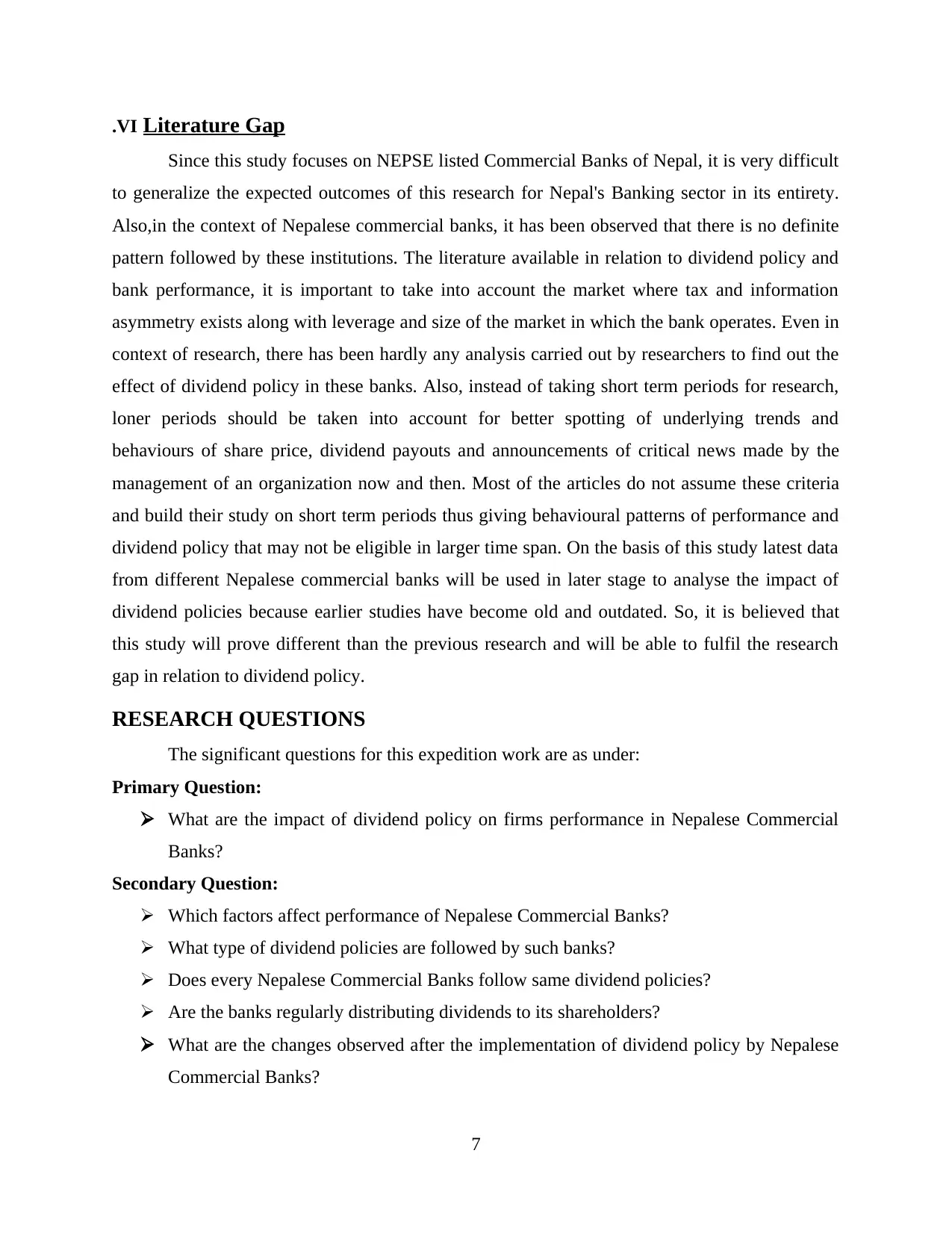
.VI Literature Gap
Since this study focuses on NEPSE listed Commercial Banks of Nepal, it is very difficult
to generalize the expected outcomes of this research for Nepal's Banking sector in its entirety.
Also,in the context of Nepalese commercial banks, it has been observed that there is no definite
pattern followed by these institutions. The literature available in relation to dividend policy and
bank performance, it is important to take into account the market where tax and information
asymmetry exists along with leverage and size of the market in which the bank operates. Even in
context of research, there has been hardly any analysis carried out by researchers to find out the
effect of dividend policy in these banks. Also, instead of taking short term periods for research,
loner periods should be taken into account for better spotting of underlying trends and
behaviours of share price, dividend payouts and announcements of critical news made by the
management of an organization now and then. Most of the articles do not assume these criteria
and build their study on short term periods thus giving behavioural patterns of performance and
dividend policy that may not be eligible in larger time span. On the basis of this study latest data
from different Nepalese commercial banks will be used in later stage to analyse the impact of
dividend policies because earlier studies have become old and outdated. So, it is believed that
this study will prove different than the previous research and will be able to fulfil the research
gap in relation to dividend policy.
RESEARCH QUESTIONS
The significant questions for this expedition work are as under:
Primary Question:
What are the impact of dividend policy on firms performance in Nepalese Commercial
Banks?
Secondary Question:
Which factors affect performance of Nepalese Commercial Banks?
What type of dividend policies are followed by such banks?
Does every Nepalese Commercial Banks follow same dividend policies?
Are the banks regularly distributing dividends to its shareholders?
What are the changes observed after the implementation of dividend policy by Nepalese
Commercial Banks?
7
Since this study focuses on NEPSE listed Commercial Banks of Nepal, it is very difficult
to generalize the expected outcomes of this research for Nepal's Banking sector in its entirety.
Also,in the context of Nepalese commercial banks, it has been observed that there is no definite
pattern followed by these institutions. The literature available in relation to dividend policy and
bank performance, it is important to take into account the market where tax and information
asymmetry exists along with leverage and size of the market in which the bank operates. Even in
context of research, there has been hardly any analysis carried out by researchers to find out the
effect of dividend policy in these banks. Also, instead of taking short term periods for research,
loner periods should be taken into account for better spotting of underlying trends and
behaviours of share price, dividend payouts and announcements of critical news made by the
management of an organization now and then. Most of the articles do not assume these criteria
and build their study on short term periods thus giving behavioural patterns of performance and
dividend policy that may not be eligible in larger time span. On the basis of this study latest data
from different Nepalese commercial banks will be used in later stage to analyse the impact of
dividend policies because earlier studies have become old and outdated. So, it is believed that
this study will prove different than the previous research and will be able to fulfil the research
gap in relation to dividend policy.
RESEARCH QUESTIONS
The significant questions for this expedition work are as under:
Primary Question:
What are the impact of dividend policy on firms performance in Nepalese Commercial
Banks?
Secondary Question:
Which factors affect performance of Nepalese Commercial Banks?
What type of dividend policies are followed by such banks?
Does every Nepalese Commercial Banks follow same dividend policies?
Are the banks regularly distributing dividends to its shareholders?
What are the changes observed after the implementation of dividend policy by Nepalese
Commercial Banks?
7
⊘ This is a preview!⊘
Do you want full access?
Subscribe today to unlock all pages.

Trusted by 1+ million students worldwide
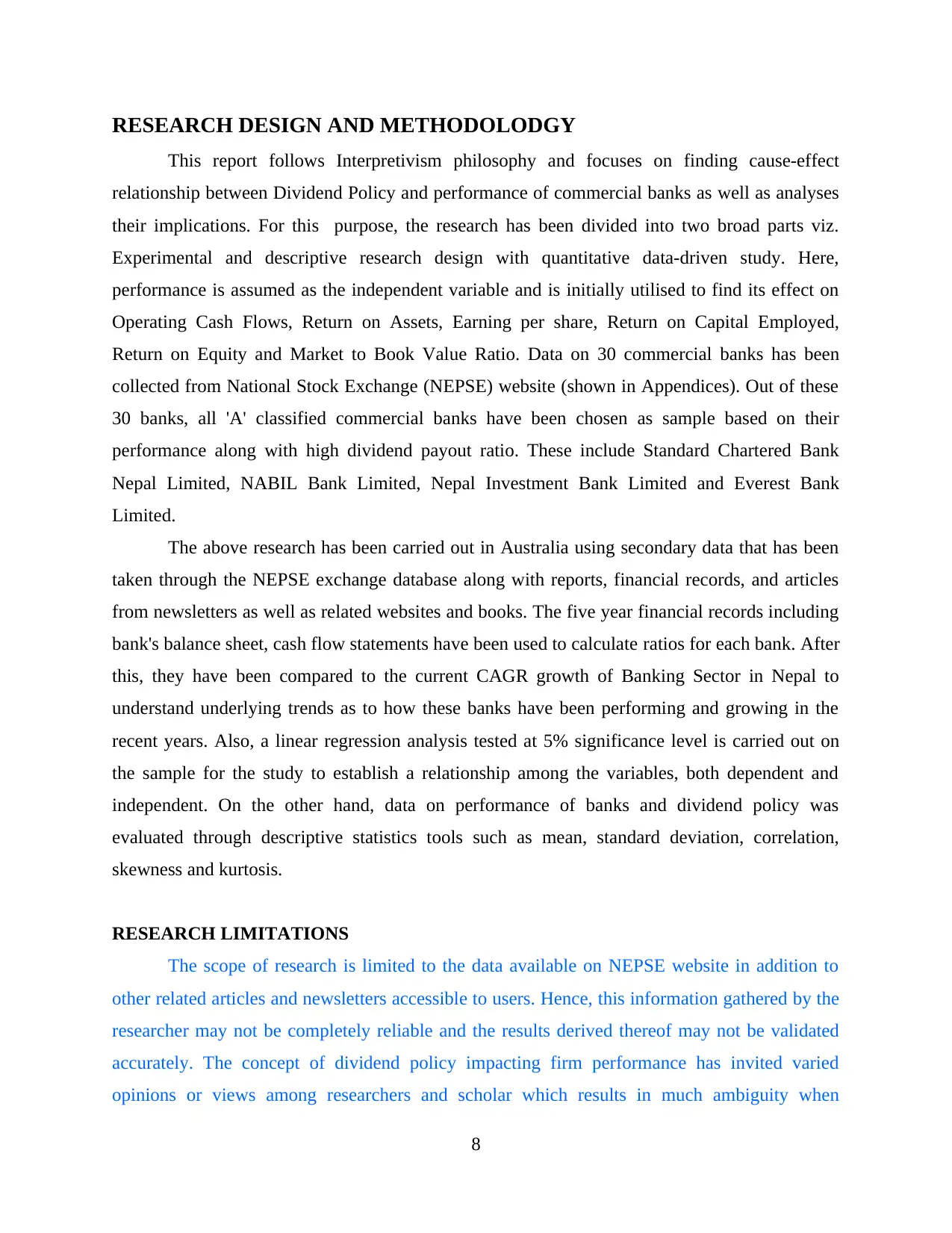
RESEARCH DESIGN AND METHODOLODGY
This report follows Interpretivism philosophy and focuses on finding cause-effect
relationship between Dividend Policy and performance of commercial banks as well as analyses
their implications. For this purpose, the research has been divided into two broad parts viz.
Experimental and descriptive research design with quantitative data-driven study. Here,
performance is assumed as the independent variable and is initially utilised to find its effect on
Operating Cash Flows, Return on Assets, Earning per share, Return on Capital Employed,
Return on Equity and Market to Book Value Ratio. Data on 30 commercial banks has been
collected from National Stock Exchange (NEPSE) website (shown in Appendices). Out of these
30 banks, all 'A' classified commercial banks have been chosen as sample based on their
performance along with high dividend payout ratio. These include Standard Chartered Bank
Nepal Limited, NABIL Bank Limited, Nepal Investment Bank Limited and Everest Bank
Limited.
The above research has been carried out in Australia using secondary data that has been
taken through the NEPSE exchange database along with reports, financial records, and articles
from newsletters as well as related websites and books. The five year financial records including
bank's balance sheet, cash flow statements have been used to calculate ratios for each bank. After
this, they have been compared to the current CAGR growth of Banking Sector in Nepal to
understand underlying trends as to how these banks have been performing and growing in the
recent years. Also, a linear regression analysis tested at 5% significance level is carried out on
the sample for the study to establish a relationship among the variables, both dependent and
independent. On the other hand, data on performance of banks and dividend policy was
evaluated through descriptive statistics tools such as mean, standard deviation, correlation,
skewness and kurtosis.
RESEARCH LIMITATIONS
The scope of research is limited to the data available on NEPSE website in addition to
other related articles and newsletters accessible to users. Hence, this information gathered by the
researcher may not be completely reliable and the results derived thereof may not be validated
accurately. The concept of dividend policy impacting firm performance has invited varied
opinions or views among researchers and scholar which results in much ambiguity when
8
This report follows Interpretivism philosophy and focuses on finding cause-effect
relationship between Dividend Policy and performance of commercial banks as well as analyses
their implications. For this purpose, the research has been divided into two broad parts viz.
Experimental and descriptive research design with quantitative data-driven study. Here,
performance is assumed as the independent variable and is initially utilised to find its effect on
Operating Cash Flows, Return on Assets, Earning per share, Return on Capital Employed,
Return on Equity and Market to Book Value Ratio. Data on 30 commercial banks has been
collected from National Stock Exchange (NEPSE) website (shown in Appendices). Out of these
30 banks, all 'A' classified commercial banks have been chosen as sample based on their
performance along with high dividend payout ratio. These include Standard Chartered Bank
Nepal Limited, NABIL Bank Limited, Nepal Investment Bank Limited and Everest Bank
Limited.
The above research has been carried out in Australia using secondary data that has been
taken through the NEPSE exchange database along with reports, financial records, and articles
from newsletters as well as related websites and books. The five year financial records including
bank's balance sheet, cash flow statements have been used to calculate ratios for each bank. After
this, they have been compared to the current CAGR growth of Banking Sector in Nepal to
understand underlying trends as to how these banks have been performing and growing in the
recent years. Also, a linear regression analysis tested at 5% significance level is carried out on
the sample for the study to establish a relationship among the variables, both dependent and
independent. On the other hand, data on performance of banks and dividend policy was
evaluated through descriptive statistics tools such as mean, standard deviation, correlation,
skewness and kurtosis.
RESEARCH LIMITATIONS
The scope of research is limited to the data available on NEPSE website in addition to
other related articles and newsletters accessible to users. Hence, this information gathered by the
researcher may not be completely reliable and the results derived thereof may not be validated
accurately. The concept of dividend policy impacting firm performance has invited varied
opinions or views among researchers and scholar which results in much ambiguity when
8
Paraphrase This Document
Need a fresh take? Get an instant paraphrase of this document with our AI Paraphraser
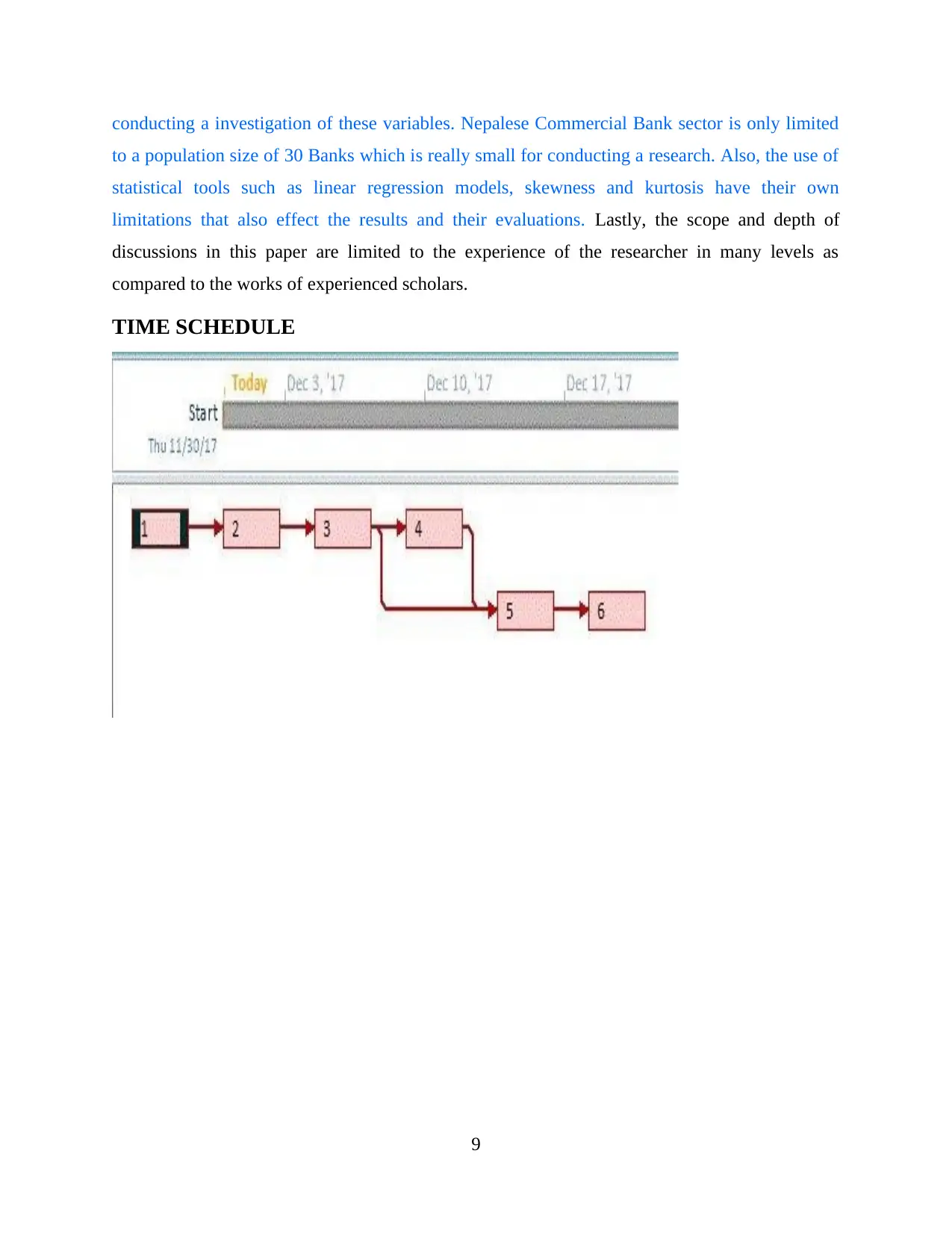
conducting a investigation of these variables. Nepalese Commercial Bank sector is only limited
to a population size of 30 Banks which is really small for conducting a research. Also, the use of
statistical tools such as linear regression models, skewness and kurtosis have their own
limitations that also effect the results and their evaluations. Lastly, the scope and depth of
discussions in this paper are limited to the experience of the researcher in many levels as
compared to the works of experienced scholars.
TIME SCHEDULE
9
to a population size of 30 Banks which is really small for conducting a research. Also, the use of
statistical tools such as linear regression models, skewness and kurtosis have their own
limitations that also effect the results and their evaluations. Lastly, the scope and depth of
discussions in this paper are limited to the experience of the researcher in many levels as
compared to the works of experienced scholars.
TIME SCHEDULE
9
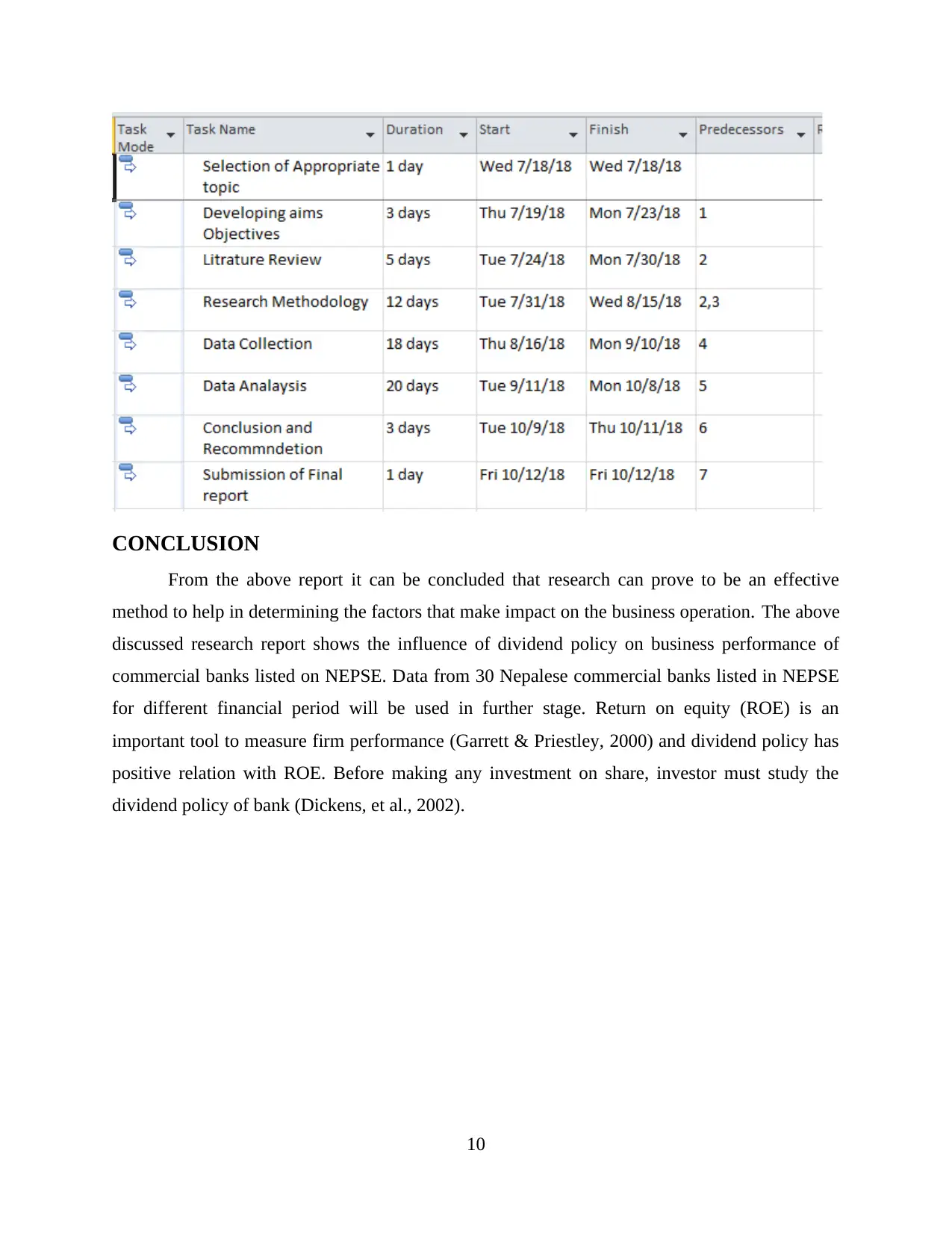
CONCLUSION
From the above report it can be concluded that research can prove to be an effective
method to help in determining the factors that make impact on the business operation. The above
discussed research report shows the influence of dividend policy on business performance of
commercial banks listed on NEPSE. Data from 30 Nepalese commercial banks listed in NEPSE
for different financial period will be used in further stage. Return on equity (ROE) is an
important tool to measure firm performance (Garrett & Priestley, 2000) and dividend policy has
positive relation with ROE. Before making any investment on share, investor must study the
dividend policy of bank (Dickens, et al., 2002).
10
From the above report it can be concluded that research can prove to be an effective
method to help in determining the factors that make impact on the business operation. The above
discussed research report shows the influence of dividend policy on business performance of
commercial banks listed on NEPSE. Data from 30 Nepalese commercial banks listed in NEPSE
for different financial period will be used in further stage. Return on equity (ROE) is an
important tool to measure firm performance (Garrett & Priestley, 2000) and dividend policy has
positive relation with ROE. Before making any investment on share, investor must study the
dividend policy of bank (Dickens, et al., 2002).
10
⊘ This is a preview!⊘
Do you want full access?
Subscribe today to unlock all pages.

Trusted by 1+ million students worldwide
1 out of 16
Related Documents
Your All-in-One AI-Powered Toolkit for Academic Success.
+13062052269
info@desklib.com
Available 24*7 on WhatsApp / Email
![[object Object]](/_next/static/media/star-bottom.7253800d.svg)
Unlock your academic potential
Copyright © 2020–2026 A2Z Services. All Rights Reserved. Developed and managed by ZUCOL.





